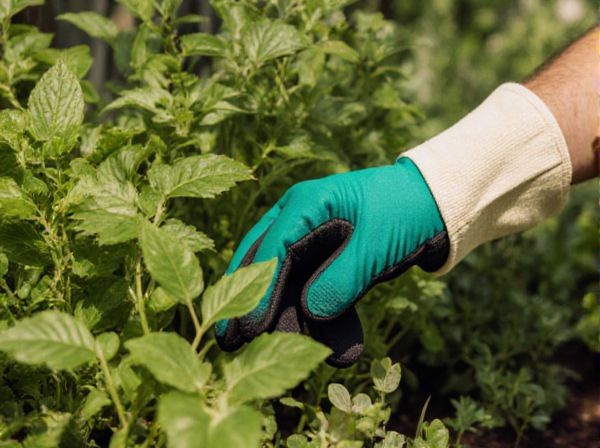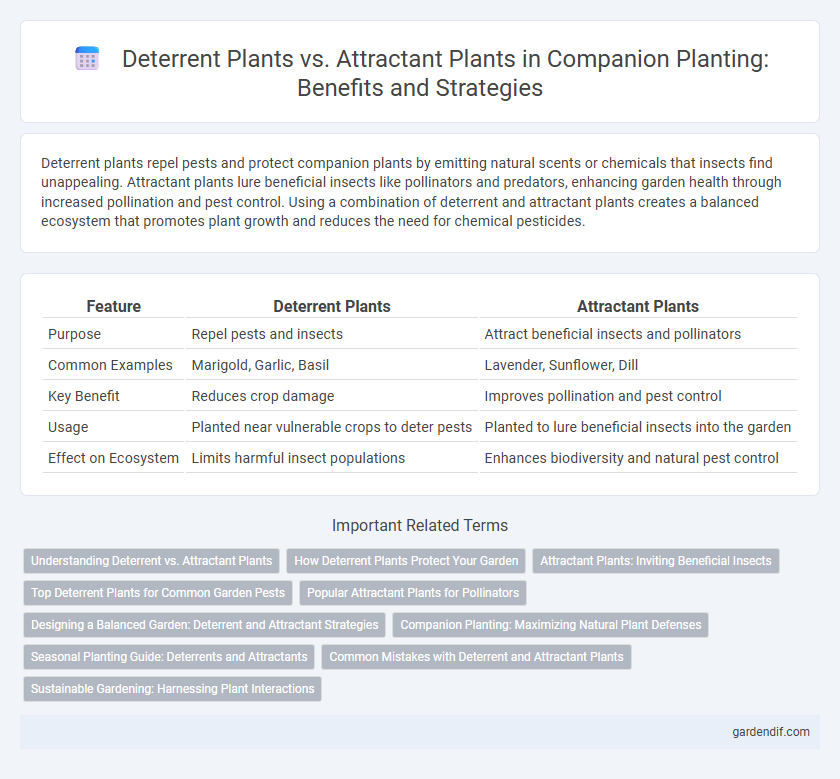
Deterrent plants vs Attractant plants Illustration
Deterrent plants repel pests and protect companion plants by emitting natural scents or chemicals that insects find unappealing. Attractant plants lure beneficial insects like pollinators and predators, enhancing garden health through increased pollination and pest control. Using a combination of deterrent and attractant plants creates a balanced ecosystem that promotes plant growth and reduces the need for chemical pesticides.
Table of Comparison
| Feature | Deterrent Plants | Attractant Plants |
|---|---|---|
| Purpose | Repel pests and insects | Attract beneficial insects and pollinators |
| Common Examples | Marigold, Garlic, Basil | Lavender, Sunflower, Dill |
| Key Benefit | Reduces crop damage | Improves pollination and pest control |
| Usage | Planted near vulnerable crops to deter pests | Planted to lure beneficial insects into the garden |
| Effect on Ecosystem | Limits harmful insect populations | Enhances biodiversity and natural pest control |
Understanding Deterrent vs. Attractant Plants
Deterrent plants, such as marigolds and garlic, emit natural chemicals that repel pests, reducing damage to companion crops. Attractant plants like nasturtiums and sweet alyssum lure beneficial insects, improving pollination and pest control. Understanding the distinct roles of deterrent and attractant plants enables effective companion planting for sustainable garden management.
How Deterrent Plants Protect Your Garden
Deterrent plants protect your garden by naturally repelling harmful pests through the release of specific chemicals that mask the scent of valuable crops or directly deter insects. Examples include marigolds, which produce thiophenes toxic to nematodes, and lavender, known for its strong fragrance that drives away aphids and whiteflies. Incorporating these plants into companion planting creates a barrier that reduces pest infestations, minimizing the need for chemical pesticides and promoting a healthier garden ecosystem.
Attractant Plants: Inviting Beneficial Insects
Attractant plants play a vital role in companion gardening by inviting beneficial insects such as ladybugs, lacewings, and parasitic wasps that naturally suppress pest populations. Species like marigolds, fennel, and dill emit specific scents and provide nectar that lure pollinators and predatory insects, enhancing plant health and crop yields. These plants create a balanced ecosystem, reducing the need for chemical pesticides while supporting biodiversity in the garden.
Top Deterrent Plants for Common Garden Pests
Top deterrent plants for common garden pests include marigolds, which repel nematodes and aphids, and lavender, effective against moths and fleas. Nasturtiums deter aphids, whiteflies, and beetles while also attracting beneficial insects. Garlic and chives emit strong odors that confuse pests like aphids, Japanese beetles, and carrot flies, providing natural pest control in companion planting.
Popular Attractant Plants for Pollinators
Popular attractant plants for pollinators include colorful flowers such as lavender, coneflowers, and bee balm, which provide abundant nectar and pollen. These plants not only support bees, butterflies, and hummingbirds but also enhance garden biodiversity and improve overall plant health. Planting clusters of attractant flowers near vegetable crops increases pollination efficiency and subsequent fruit yield.
Designing a Balanced Garden: Deterrent and Attractant Strategies
Designing a balanced garden involves integrating deterrent plants such as marigolds and garlic with attractant plants like lavender and sunflowers to naturally manage pests and support pollinators. Deterrent plants emit specific scents or chemicals that repel harmful insects, while attractant plants provide nectar and habitat, encouraging beneficial species to thrive. Strategic placement enhances plant health and biodiversity, reducing the need for chemical interventions and promoting sustainable growth.
Companion Planting: Maximizing Natural Plant Defenses
Companion planting leverages deterrent plants such as marigolds and garlic to repel harmful pests, while attractant plants like nasturtiums and sweet alyssum lure beneficial insects that enhance pollination and pest control. Integrating these plants strategically maximizes natural defenses, reducing the need for chemical pesticides and promoting healthier crop growth. This ecological balance improves overall garden productivity by creating a dynamic environment that supports pest management and biodiversity.
Seasonal Planting Guide: Deterrents and Attractants
Seasonal planting guides differentiate deterrent plants, such as marigolds and garlic, which repel pests during spring and summer, from attractant plants like nasturtiums and sunflowers that lure beneficial insects for pollination and pest control. Strategically alternating these plants throughout the growing seasons enhances garden health by naturally managing pest populations and boosting crop yields. Effective companion planting relies on aligning these deterrents and attractants with specific seasonal cycles to optimize plant growth and protect against damage.
Common Mistakes with Deterrent and Attractant Plants
Common mistakes with deterrent and attractant plants include improper selection and placement, which can reduce their effectiveness in companion planting. Many gardeners fail to consider the specific pests targeted, planting deterrent species that don't address local pest problems or attractants that inadvertently lure unwanted insects. Overcrowding companion plants can also impede growth and diminish their protective benefits, undermining the intended pest control strategy.
Sustainable Gardening: Harnessing Plant Interactions
Deterrent plants such as marigolds and nasturtiums naturally repel pests, reducing the need for chemical pesticides in sustainable gardens. Attractant plants like fennel and dill lure beneficial insects, enhancing pollination and pest control through biological interactions. Combining these companion plants promotes ecosystem balance, improves soil health, and supports biodiversity in eco-friendly gardening practices.
Deterrent plants vs Attractant plants Infographic

 gardendif.com
gardendif.com